Renard 64XC Construction: Difference between revisions
| Line 95: | Line 95: | ||
* Install the Power LED, D7. The LEDs are polarized and must be installed with the proper orientation. The long lead is the anode and must be placed in the round solder pad that is marked with an "A". The flat side of the LED (the short lead side) goes in the square pad marked with a "K". This is exactly opposite of the Channel LEDs in the next step! Bend back the leads slightly as done with the resistors. Solder one lead and check from proper alignment. Then, solder the other lead and trim off the excess. | * Install the Power LED, D7. The LEDs are polarized and must be installed with the proper orientation. The long lead is the anode and must be placed in the round solder pad that is marked with an "A". The flat side of the LED (the short lead side) goes in the square pad marked with a "K". This is exactly opposite of the Channel LEDs in the next step! Bend back the leads slightly as done with the resistors. Solder one lead and check from proper alignment. Then, solder the other lead and trim off the excess. | ||
|| [[Image:Renard 64XC Power LED D7 Install.jpg | 200px]] | || [[Image:Renard 64XC Power LED D7 Install.jpg | 200px]] | ||
|- | |||
| | |||
The BOM calls our for spades. However, many users prefer to use a single 2 position terminal here. Install one (1) two position terminal block for 6.3VAC input. | |||
|| [[Image:Renard 64XC Terminal Install.jpg | 200px]] | |||
|- | |- | ||
| | | | ||
* Install one (1) 2-pin vertical header JP1. These headers are not polarized so the orientation is not important. Once again, a small piece of tape works well to hold the header in place. Solder one lead, check for alignment, then solder the opposite lead. No trimming is required for this component. | * Install one (1) 2-pin vertical header JP1. These headers are not polarized so the orientation is not important. Once again, a small piece of tape works well to hold the header in place. Solder one lead, check for alignment, then solder the opposite lead. No trimming is required for this component. | ||
|| [[Image:Renard 64XC JP1 Install.jpg | 200px]] | || [[Image:Renard 64XC JP1 Install.jpg | 200px]] | ||
|- | |- | ||
| | | | ||
| Line 122: | Line 122: | ||
| | | | ||
* Install the voltage regulator U1. The voltage regulator must be installed correctly. The voltage regulator's tab/heat sink must be aligned with wider line of the PCB silkscreen outline (facing outwards to the PCB edge). Insert the component and then flip the board over. Solder one pin...then flip the board back over and check for alignment. Simply reheat the joint and position the regulator so that is is square to the board. Solder the other two leads and trim off the excess. | * Install the voltage regulator U1. The voltage regulator must be installed correctly. The voltage regulator's tab/heat sink must be aligned with wider line of the PCB silkscreen outline (facing outwards to the PCB edge). Insert the component and then flip the board over. Solder one pin...then flip the board back over and check for alignment. Simply reheat the joint and position the regulator so that is is square to the board. Solder the other two leads and trim off the excess. | ||
|| [[Image:Renard 64XC U1 Install.jpg| 200px]] | |||
|- | |- | ||
| | | | ||
* Install the 6800uF capacitor C1. This capacitor is polarized and must be installed correctly. The capacitor should have a black stripe on the body to indicate the negative lead. The positive lead of the capacitor will be the longer lead. Make sure that the positive lead is placed in the square solder pad. Then, bend the leads back slightly to hold the capacitor in place. Solder and trim the leads the same as the other passives. | * Install the 6800uF capacitor C1. This capacitor is polarized and must be installed correctly. The capacitor should have a black stripe on the body to indicate the negative lead. The positive lead of the capacitor will be the longer lead. Make sure that the positive lead is placed in the square solder pad. Then, bend the leads back slightly to hold the capacitor in place. Solder and trim the leads the same as the other passives. | ||
|| [[Image:Renard 64XC C1 Install.jpg| 200px]] | |||
|- | |- | ||
|colspan="2" |<blockquote> If you are unsure about your ability to build this board, then you should go to [[Beginners Setup Guide Renard 64 | The Beginner's Setup Guide]] at this point. [[Beginners Setup Guide Renard 64 | The Beginner's Setup Guide]] will walk you thru some initial tests to make sure that everything is working correctly before inserting the IC chips. </blockquote> | |colspan="2" |<blockquote> If you are unsure about your ability to build this board, then you should go to [[Beginners Setup Guide Renard 64 | The Beginner's Setup Guide]] at this point. [[Beginners Setup Guide Renard 64 | The Beginner's Setup Guide]] will walk you thru some initial tests to make sure that everything is working correctly before inserting the IC chips. </blockquote> | ||
Revision as of 00:30, 31 August 2010
Board Assembly
- Note: Pictures are being added daily and the sequence is changing based on an actual assembly.
- The following sequence of steps is by no means the only way to Assembly the Renard 64. It is simply a suggested order of assembly. Many builders have varied opinions on what the order should be. In general, you start with the "shortest" items and work towards the tallest. This generally means that resistors are first and connectors are last but every board is different.
- A good temperature controlled soldering iron should be used for building the Renard 64. Try to get the smallest diameter rosin core solder you can find (either 60/40 or 63/37). DO NOT USE LEAD FREE SOLDER!! This takes special equipment and a very high skill set that few DIYers have. If you do use Lead Free Solder and have problems (which is VERY likely) please let us know when you ask for help. Lead Free Solder can look like a good joint but still not be electrically conductive.
- One safety note is prudent here. Solder is METAL (lead and tin)...In order to use it,it must be MELTED. HOT, Molten Metal can BURN! Also, metal leads get hot while soldering. So, any unprotected fingers that are being used to "hold" a component in place will be burned!! Painter's tape is one way of holding items down while the board is being flipped over. Another way is to use another unpopulated board or flat surface to allow the board to be flipped while keeping the components in place.
- NOTE: The part numbers referenced in the following instructions are those taken from the Renard 64 BOM.
| |
|
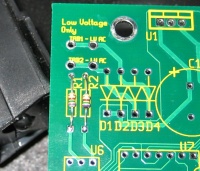
|
|
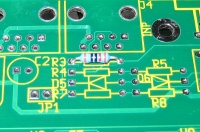
|
|
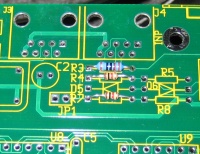
|
|

|
|
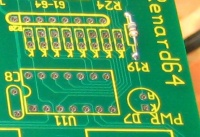
|
|
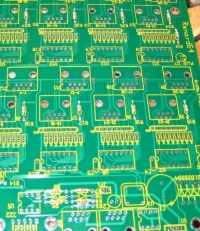
|
|
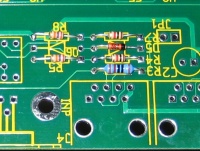
|
|
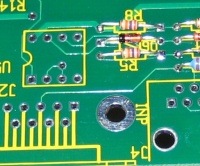
|
|
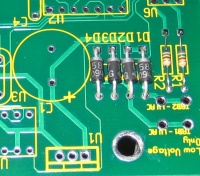
|
| |
|
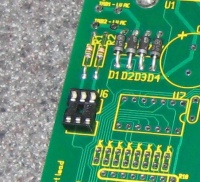
|
|
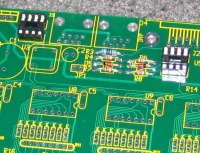
|
|
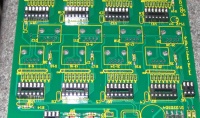
|
| |
|

|
|
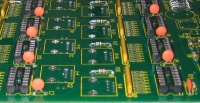
|
|

|
|

|
|
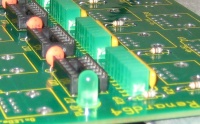
|
|
The BOM calls our for spades. However, many users prefer to use a single 2 position terminal here. Install one (1) two position terminal block for 6.3VAC input. |
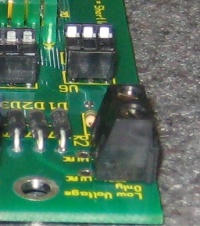
|
|
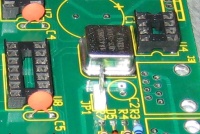
|
|
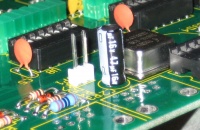
|
|
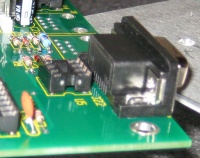
|
|
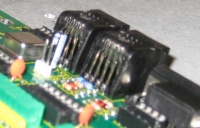
|
|
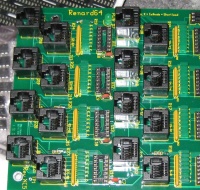
|
|
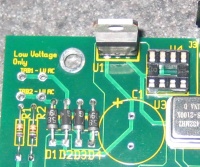
|
|
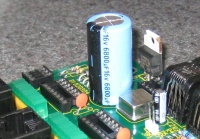
|
| |
| |
| |
| |
| |
| |